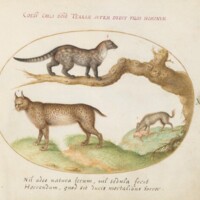Civet (Civette)
Dublin Core
Title
Subject
Description
Despite the Europeans’ awareness of the civet cat in the early fifteenth century, it was not until the sixteenth and seventeenth centuries that civet would increasingly acquire its fame and come to be imported into Europe with the expansion of European exploration.
In 1470, the Portuguese monopolized Guinea’s civet cats, from which they made considerable profit. Late fifteenth- and sixteenth-century sources indicate Europeans’ “discovery” of civet cats in East Africa, particularly Ethiopia, as well as in India and China. Thus, various species of the civet cat had become available to European merchants by the beginning of the seventeenth century.
Source
In Ms. Fr. 640, civet is used in combination with other scents of animal origin, such as ambergris and musk, for making perfume.
Fol. 163r – “Perfumer”
They readily put half of amber & half of musk & very little civet, because amber always overtakes the principal scent of musk.
To spare the amber, they readily put a little musk in the white layers, which gives a more forceful scent. But to remove or hide the blackness of the musk, they put in a bit of wheat starch from England, which is perfectly white.
To perfume with white amber in the Portuguese fashion, take a huchau of amber, well broken up. And having put in a small silver bowl a spoonful of flower oil, or lacking that, ben oil, that is to say, a silver spoon that one uses at the table, put in your ambergris & place all on a low fire, and it will melt quickly if your amber is good, & it will remain there without lumps. Once all melted, put in the size of a pine nut of civet, & make it melt, & mix it well together. Next, take your gloves, well-cleaned & well-dried, & dipping the tip of your finger very lightly on the edge of the oil, spread it on the glove, little by little & with patience, & rub the glove between your hands, & trace the fingers & the stitches, one after the other. And leave it to dry. Next, trace again as before until the amber is all laid down.
Contributor
Chris Wemmer, "Civets and Genets," in The Encyclopedia of Mammals (Oxford University Press, 2006), https://www-oxfordreference-com.ezproxy.cul.columbia.edu/view/10.1093/acref/9780199206087.001.0001/acref-9780199206087-e-30.
Karl H. Dannenfeldt, “Europe Discovers Civet Cats and Civet.” Journal of the History of Biology 18, no. 3 (1985): 403–31.
Image: Joris Hoefnagel, Plate 14: A Civet, a Lynx, and a Hyena, from Animalia Qvadrvpedia et Reptilia (Terra), watercolor and gouache on vellum, c. 1575/1580.
*The top figure labeled #1 represents civet.
Helena Seo, Columbia University
